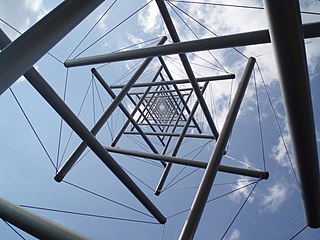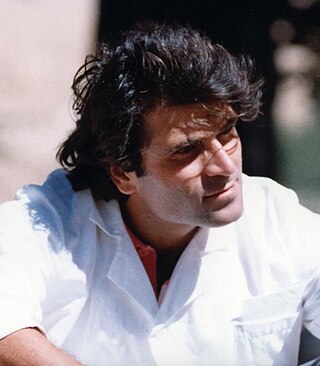Related Research Articles

Kenneth Duane Snelson was an American contemporary sculptor and photographer. His sculptural works are composed of flexible and rigid components arranged according to the idea of 'tensegrity'. Snelson preferred the descriptive term floating compression.

Lee Bontecou was an American sculptor and printmaker and a pioneer figure in the New York art world. She kept her work consistently in a recognizable style, and received broad recognition in the 1960s. Bontecou made abstract sculptures in the 1960s and 1970s and created vacuum-formed plastic fish, plants, and flower forms in the 1970s. Rich, organic shapes and powerful energy appear in her drawings, prints, and sculptures. Her work has been shown and collected in many major museums in the United States and in Europe.
Keith Sonnier was a postminimalist sculptor, performance artist, video and light artist. Sonnier was one of the first artists to use light in sculpture in the 1960s. With his use of neon in combination with ephemeral materials he achieved international recognition. Sonnier was part of the Process Art movement.
The Park Place Gallery was a contemporary cooperative art gallery, in operation from 1963 to 1967, and was located in New York City. The Park Place Gallery was a notable as a post-World War II gallery for both its location and that it supported a group of artists working with geometric abstraction and space.
Tom Burr is an American conceptual artist. Burr's artwork explores the relationships between, "the built environment, subjectivity, and historical persona". He is based in New York City.
James Arthur Surls is an American modernist artist and educator, known for his large sculptures. He founded the Lawndale Alternative Arts Space at the University of Houston in the 1970s.
Peter Forakis was an American artist and professor. He was known as an abstract geometric sculptor.

Tanya Preminger, is an artist working in various media: environmental art, site-specific art, ephemeral art, sculpture, installation and photography. She is mostly known for her land art projects and large-scale stone sculptures.
Sanford Biggers is a Harlem-based interdisciplinary artist who works in film/video, installation, sculpture, music, and performance. An L.A. native, he has lived and worked in New York City since 1999.

Maria Nordman is a German-American sculptor and conceptual artist. She is known for creating the contexts of FILM ROOMS starting in 1967: FILM ROOM EAT 1967-PRESENT and FILM ROOM EXHALE 1967- PRESENT. These two works are the fulcrum of other works that follow, of other works that follow, enabling new considerations of rooms as sculpture. Her works in film, still photography, and sculpture variously connect to writing, musical projects, architecture, public space, and performance.

Ronald Bladen was a Canadian-born American painter and sculptor. He is particularly known for his large-scale sculptures. His artistic stance, was influenced by European Constructivism, American Hard-Edge Painting, and sculptors such as Isamu Noguchi and David Smith. Bladen in turn had stimulating effect on a circle of younger artists including Carl Andre, Donald Judd, Sol LeWitt and others, who repeatedly referred to him as one of the 'father figures' of Minimal Art.
Liz Magor is a Canadian visual artist based in Vancouver. She is well known for her sculptures that address themes of history, shelter and survival through objects that reference still life, domesticity and wildlife. She often re-purposes domestic objects such as blankets and is known for using mold making techniques.
Kaari Upson was an American artist. The bulk of Upson’s career was devoted to a single series titled The Larry Project – paintings, installations, performances, and films inspired by a collection of one man's personal items she found in 2003. The Larry Project was exhibited at the Hammer Museum in Los Angeles in 2008, as part of their program Hammer Projects. Her work resides in the public collections of the Whitney Museum of American Art, the Museum of Contemporary Art, Los Angeles, and the Institute of Contemporary Art, Boston and is known for exploring themes of psychoanalysis, obsession, memory, and the body. She had lived and worked in Los Angeles.
Lisa Schulte is an American artist, also known as "The Neon Queen", who is best known for her work in expressive neon sculpture. Schulte started bending neon in the early 1980s, creating custom neon signs and neon prop rentals to the entertainment industry under her Los Angeles-based neon studio, Nights of Neon. She is recognized for working with light as an artist and designer, and owner of one of the largest neon collections in the world.
Olga Balema is a Ukrainian-born American artist and sculptor. One of the major concerns of her work is form, another material. Another is paying attention to where and how things go into a space. Sometimes the work can be called site respondent, other times it responds only to itself. Her practice presents mundane materials in evocative forms. She is based in New York City, New York.

The Field was the inaugural exhibition at the National Gallery of Victoria’s new premises on St Kilda Road, Melbourne. Launched by the director of London’s Tate gallery, Norman Reid, before an audience of 1,000 invitees, it was held between held 21 August and 28 September 1968. Hailed then, and regarded since as a landmark exhibition in Australian art history, it presented the first comprehensive display of colour field painting and abstract sculpture in the country in a radical presentation, between silver foil–covered walls and under geometric light fittings, of 74 works by 40 artists. All practised hard-edge, geometric, colour and flat abstraction, often in novel media including coloured or transparent plastic, fluorescent acrylic paints, steel and chrome. The art was appropriate to a launch of the new venue itself, designed by architect Roy Grounds, and emphatically rectilinear; cubes nested in a basalt rectangular box amongst the other buildings of the new Arts Centre, each based on a geometric solid. Echoing emerging international stylistic tendencies of the time, The Field sparked immediate controversy and launched the careers of a new generation of Australian artists.

Rudy Rahme is a Lebanese sculptor, painter and poet.

Kennedy Yanko is an American sculptor, painter and installation artist working with paint skins and found metal. Yanko sources material from salvage yards, utilizing discarded objects that she then manipulates or modifies to realize her vision. Her abstract work draws upon surrealism, abstract expressionism and physical austerities.
Toshio Odate is a Japanese-born American sculptor, woodworker, craftsmen, author, and educator. He specializes in Japanese woodworking and is a noted shoji maker. He is the author of, Japanese Woodworking Tools: Their Tradition, Spirit and Use.
David Ross Novros, is an American artist. He is known for his minimalist geometric paintings, shaped canvases, and his use of color. He has also studied fresco painting extensively.
References
- 1 2 3 4 5 6 7 8 9 10 Strobl, Andreas (2009). "Grosvenor, Robert". Allgemeines Künstlerlexikon Online [Artists of the World Online] (in German). De Gruyter.
- 1 2 "Robert Grosvenor". The Museum of Modern Art (MoMA). Retrieved 2021-09-16.
- 1 2 "Robert Grosvenor's Fractured Beams". Artforum.com. May 1974. Retrieved 2021-09-16.
{{cite web}}: CS1 maint: url-status (link) - 1 2 ""Reimagining Space: The Park Place Gallery Group in 1960s New York" at Blanton Museum of Art". Artforum.com. Retrieved September 17, 2021.
{{cite web}}: CS1 maint: url-status (link) - 1 2 Landfield, Ronnie (June 1995). "Lyrical Abstraction". www.abstract-art.com/. Archived from the original on October 20, 2012. Retrieved September 17, 2021.
- 1 2 Lindquist, Greg (2010-04-02). "ArtSeen: Robert Grosvenor". The Brooklyn Rail. Retrieved 2021-09-16.
{{cite web}}: CS1 maint: url-status (link) - ↑ Pepe Karmel (8 March 1996), Art in Review New York Times .
- ↑ Alex Greenberger (23 January 2023), Minimalist Sculptor Robert Grosvenor Leaves New York’s Paula Cooper Gallery After More Than 50 Years ARTnews .
- ↑ Alex Greenberger (23 January 2023), Minimalist Sculptor Robert Grosvenor Leaves New York’s Paula Cooper Gallery After More Than 50 Years ARTnews .
- ↑ Galvan, Abraham (2021-03-23). "Institute of Contemporary Art issues children's video game". Miami Today. Retrieved 2021-09-17.
{{cite web}}: CS1 maint: url-status (link) - ↑ "Robert S. Grosvenor". John Simon Guggenheim Foundation. Retrieved 2021-09-16.
{{cite web}}: CS1 maint: url-status (link) - ↑ Henderson, Linda Dalrymple (2008). La Línea Continua: The Judy and Charles Tate Collection of Latin American Art. The Blanton Museum of Art. Blanton Museum of Art, University of Texas at Austin. p. 104. ISBN 978-0-9815738-0-9.
- ↑ "Art in Society and Documenta 8". Art in America. F.F. Sherman. 1987. p. 256.
- ↑ Contemporary Artists. Volume 9 of Contemporary Arts Series. St. James Press. 1996. p. 462. ISBN 978-1-55862-183-1.
- ↑ "Preliminary Drawings, May 23–Aug 31, 1970". The Museum of Modern Art (MoMA). Retrieved 2021-09-16.
{{cite web}}: CS1 maint: url-status (link) - 1 2 "Robert Grosvenor". Institute of Contemporary Art, Miami. Retrieved 2021-09-16.
{{cite web}}: CS1 maint: url-status (link)